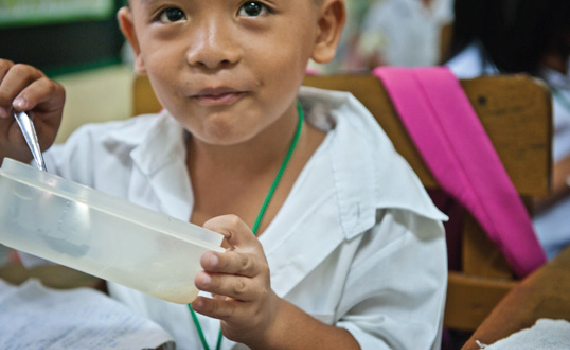
SCHOOL HEALTH AND NUTRITION IN SOUTHEAST ASIA’S PRIMARY SCHOOLS
This is the full transcript of the workshop summation delivered by SEAMEO INNOTECH’s Educational Research and Innovation Office Manager, Mr. Philip Purnell at the closing ceremony of the “Regional Research Workshop on School Health and Nutrition in Primary Schools in Southeast Asia” on 29 July 2013.
The importance of this workshop was to raise school health and nutrition as a priority; this is something that should not be in the periphery. This workshop highlighted school health and nutrition as central to good learning. If we really want to support the holistic development of the children in our own countries, school health and nutrition must be in the center of what we do at the school level, in our policies, in our capacity building, in our research, and in our infrastructure programs. It has been marginalized for too long, and when we see the statistics, we recognize the result of not doing effective school health and nutrition in terms of negative impacts on physical and cognitive development.
When we see these statistics—they are not just numbers; they are individual children whose possibilities to grow up and reach their full potentials are being compromised as a result of these health conditions. This is important as a mandate of education ministries to promote their full realization of children’s potential, and therefore health and nutrition must be in the main agenda.
When we’re talking about school health, we’re talking about ensuring healthy environments that promote learning. Any factors that prevent or undermine the learning of the children need to be addressed as a priority.
We are now in agreement in this workshop about the critical role of the school and its community as a local agent of change. In INNOTECH, we are promoting the principal as agent of change, reform, and transformation. And it seems to apply even more so in the field of school health and nutrition. With that, comes the critical role of the community, and the partnerships with the community, with the private sector, with the NGOs, with parents and other family members in the community.
There are a lot of commonalities across the region; we share similar problems. But then the variances are not just across countries but also within countries, within communities, within provinces, between upland and lowland. These differences are very insightful, and we have to be able to respond to these challenges within our communities and within our countries.
Another takeaway was that children should not just be recipients of school health and nutrition programs; they need to be active partners and agents of their own improvement. It is important to look into ways to further encourage student empowerment, so they can be effective partners of teachers, school principals, and communities in their school health and nutrition program development.
From the last presentation that was shared, which highlighted the importance of up-to-date, accurate information on school health issues, we see that it’s not enough to have health information. We need them to make decisions and to improve practice. If we use information for decision-making, for program design, for policy formulation and to inform our various practices, it can have higher impact. Similarly with policies, we recognize that we need an enabling policy environment to make change possible, but good policies, unless translated into action, are not helpful. We may be good in making policies, but sometimes weak in implementing them; perhaps weaker in documenting what we have implemented; and even worse in evaluating the impact of what we did to see if it’s worthwhile.
For educators, it is important to address the issue of how to integrate health issues across the educational process and the curriculum. But beyond the curriculum, we realize now the critical importance of every teacher, not just the health and physical education teachers, but every teacher—math teachers, English teachers, social studies teachers, values teachers. Whatever the content area is, health issues must be integrated into subjects to reaffirm key messages, so that every teacher becomes a school health advocate, not just relying on health personnel.
We saw so many challenges, but there’s also hope for many solutions that are emerging from the agenda that we prepared. It looks doable while ambitious, and with the workshop inputs, INNOTECH will be certainly doing its best to move forward a high-impact, scalable and sustainable school health and nutrition agenda.
For all of this to happen, we need investments in infrastructure. But probably more important, we also need to invest in our people. We need to invest in capacity building targeted towards the critical training needs we have identified. And we need to support teachers, principals, district supervisors and other officials to be able carry out and support the school health promotion agenda that we have outlined.





